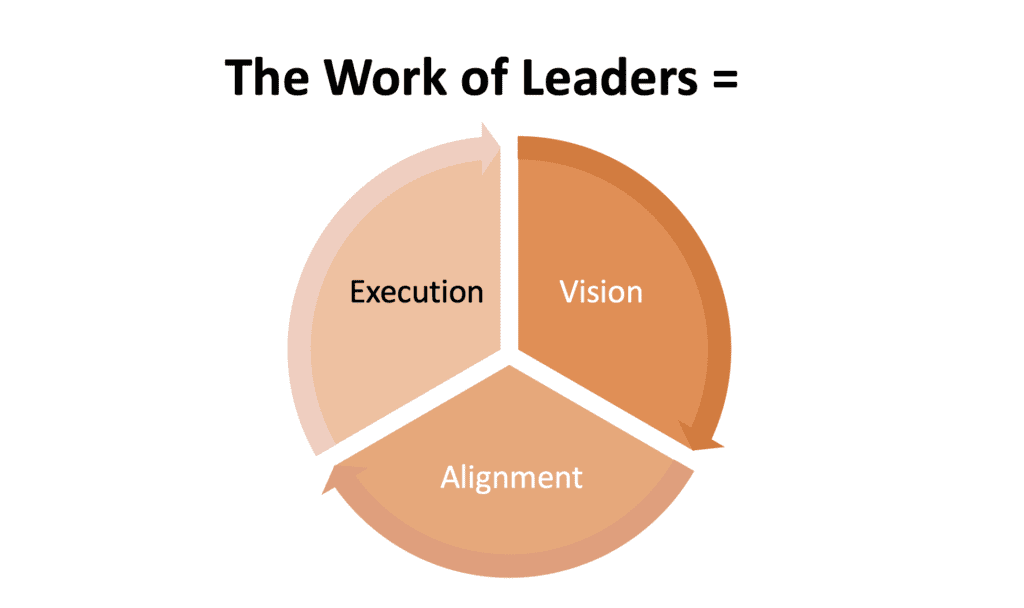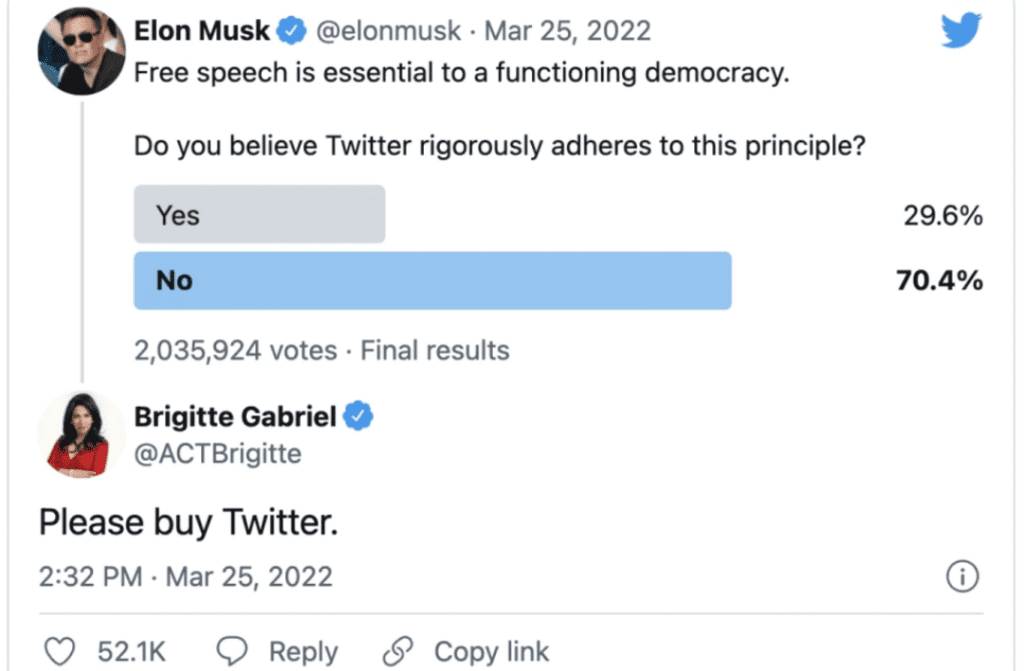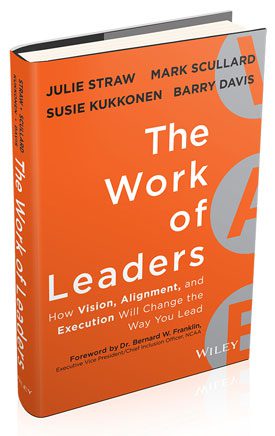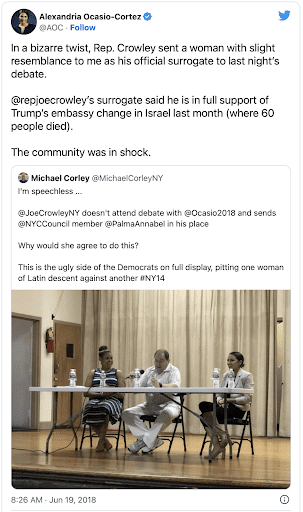Learn these 3 Leadership Mindsets

This definition of a leader’s mindset can be categorized into three distinct responsibilities that should be a leader’s primary focus:
- Craft a Vision: leaders must work to imagine an improved future that their group/organization will turn into reality through its work.
- Build Alignment: leaders should work to help everyone understand and become committed to the direction of the shared vision.
- Champion the Execution: Leaders must work to ensure that the conditions are present for the imagined future to become a reality.
A team of researchers from John Wiley & Sons outlined these three mindsets.
The researchers identified and developed the leadership mindsets through an extensive study that reviewed survey data from current leaders in Fortune 500 companies, a review of leadership material from business academics (i.e., Peter Senge), business literature (i.e., Peter Drucker & Warren Bennis), and business research (i.e., Jim Collins), and survey data from 5,900 training participants.
Their research lasted more than 3 years, resulting in a book titled, The Work of Leaders.
Today, the insights from the book are now offered as a Leadership Assessment Tool. It combines the three mindsets with insights from Everything DiSC.
The leadership mindsets were developed with accessibility in mind. Many leadership development courses focus on nuanced strategies that might not make sense for every type of leader.
The Work of Leaders framework focuses on ensuring that any leader can walk away with a better understanding of how they should use their time throughout their day when they focus on the three mindsets listed above.
Leadership Mindset #1: Crafting a Vision
After the Space Shuttle Challenger explosion, the US was losing interest in space. NASA’s budget remained the same while the U.S. invested its growing budget in other areas.
To renew attention toward the cosmos, a young entrepreneur teamed up with the Mars Society to develop a plan to land an experimental greenhouse and grow plants on Mars.
This vision led the entrepreneur to Russia, where he sought to purchase rockets that could carry a greenhouse to Mars.
Unfortunately, the Russian Agency was distancing itself from the U.S., and buying a rocket would be very expensive.

Likely, you know that the entrepreneur in this story is Elon Musk.
The leadership mindset of Crafting a Vision is clearly evident in this story. There are a few different drivers that drive this leadership mindset of Crafting a Vision:
- Allowing Exploration: When crafting a vision, allow yourself to remain open to new ideas. Musk initially thought he could buy a rocket from Russia to get to Mars. When that didn’t work out, he allowed new ideas (like starting a new company) to help him stay focused on his vision.
- Being Bold: Going to Mars is a bold vision, coupled with other equally bold supporting decisions: creating a new company, building new technology, and making current technology more cost-effective.
- Testing Assumptions: Musk didn’t develop his vision of going to Mars alone. He joined and worked with the Mars Society first. By joining a group of like-minded individuals, he was able to explore how the vision could work and also have people counsel him to make his ideas better.
What happens when you don't Craft a Vision...
The story of SpaceX is interesting because of the decision that Elon Musk would make in 2022; he purchased Twitter to ‘restore free speech.’
Musk’s approach to starting SpaceX and his decision to purchase Twitter couldn’t have been more different and offers a great case study of when leaders don’t engage in the mindset of crafting a vision.

Musk purchased Twitter with a vision to improve free speech.
However, it seems Musk might not have done as good of a job of going through the process of fully developing his vision.
From the outset, it seems that he could have done a better job of testing assumptions. Here are two thoughts that he should have considered:
- Are general safeguards needed to allow for free speech to exist on Twitter?
- Would our society benefit without unlimited free speech if we had a better means of engaging in dialogue?
Many of Twitter’s active users left the platform because they disagreed with Musk’s vision for the social media organization.
Of course, it’s too early to know if his vision will become a reality and if Musk successfully makes Twitter a better platform for free speech and open dialogue.
In the next section, we will discuss the next leadership mindset of building alignment to make your vision a reality. It’s clear that Musk probably missed thinking through what would be needed to motivate change within Twitter too.
Leadership Mindset #2: Building Alignment
One of the best examples of building alignment is seen through the U.S. political spectrum.
Candidates must align voters with their vision for how they will work for the districts they represent. If they don’t, they aren’t elected, and their vision never materializes.
The U.S. system is not perfect. However, it is a great representation of how the leadership mindset of building alignment works.
In 2017, a bartender in New York decided that her representative in Congress didn’t have her or her community’s best interests in mind. She had experience working on campaigns, and she decided to run for office. When she announced her candidacy, she was the first person to challenge her congressional representative in a primary since 2004.
Her primary opponent didn’t take her candidacy seriously and only agreed to debate her once. Additionally, many of the media outlets didn’t cover her candidacy. For her to reach potential voters and build alignment with them, she had to take a different approach.
Unlike her primary opponent, she was active on social media, and she used Twitter and other social media platforms to structure her messages, provide examples of why her district needed new leadership, and also to engage with prospective voters.
This candidate was Alexandria Ocasio-Cortez (she is nationally recognized by her initials, AOC).
Ocasio-Cortez adeptly used the Leadership Mindset of building alignment (along with the mindset of Crafting a Vision). In her campaign, Ocasio-Cortez used the following drivers to build alignment with voters in her district:
Communicating with Clarity: In her campaign, Alexandria Ocasio-Cortez leveraged social media, which allowed her to expand and clarify her messages. A famous example was when Ocasio-Cortez and Representative Joseph Crowly were supposed to join a town hall together. Instead, Crowly tried to out-maneuver Ocasio-Cortez by sending an NYC Council Member who was also Latino to represent Crowly. Ocasio-Cortez hammered Crowly on social media as someone who leverages race to keep communities fighting internally.
Leadership Mindset #3: Championing Execution
The final leadership mindset is taking all of the work that you have done in developing a clear vision and building an aligned team to make it a reality. Being a champion for execution is the final leadership mindset, and it has three primary drivers:
- Build momentum by being driven and initiating change
- Establish structure by having a plan and an in-depth analysis
- Be receptive to feedback that addresses problems and celebrate success on your team by offering praise.
One of the greatest examples of championing execution can be found in the March on Washington and Martin Luther King Jr.’s work to win civil rights for African Americans.

The march attracted 260,000 people, and it became the turning point in establishing rights for African Americans through the Civil Rights Act of 1964.
Leading up to the March on Washington, King built momentum for the civil rights movement (and the March on Washington) through many equally impactful demonstrations.
Months before the March on Washington, King and the Southern Christian Leadership Conference (SCLC) lead a March on Birmingham. This campaign likely was the driving force behind the success of the March on Washington because it exposed the harsh realities of living as an African American in a southern city.
However, during the planning stages of the March on Washington, King and his organizers decided that the March wouldn’t include acts of civil disobedience, which was common in his other campaigns, based on feedback that he received from the Kennedy administration.
This was likely a hard decision to make because civil disobedience was the greatest tool that King and the SCLC could use. However, the decision to forgo using civil disobedience likely allowed for the passing of the Civil Rights Act.
Develop and Apply The Three Leadership Mindsets
Now that you know the three primary leadership mindsets, you will need to take the next step in developing them.
To start this process, take time to think about the mission and vision of your organization, team, or department. If you haven’t written a mission or vision statement, now is a great time to work on one. It’s impossible to develop these leadership mindsets if you don’t know what you are working towards.
Once you have your mission or vision statement written down, consider the following questions:
- How aligned is the work that you and your team are achieving with your mission/vision?
- Does your team/organization/division have the resources to work towards accomplishing your mission/vision every day?
These two questions will help you take the next step in moving from understanding the three leadership mindsets to applying them.
For more help in learning how to leverage these mindsets and applying them, consider taking any of the below additional steps:
- Buy the book The Work of Leaders (Available for $19.95 + shipping)
- Listen to our interview with an author of the Work of Leaders (Free!)
- Complete your Work of Leaders Assessment ($135)
- Engage us to facilitate a leadership development process that is built around the Work of Leaders (contact us to learn more)




